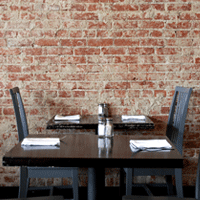Whether it’s smaller footprints, mobile trucks or pop-ups, restaurants are evolving daily.
In recent years, as the economy has gone through seismic challenges, many operators have opted to reduce the footprint of their operations or introduce new concepts such as mobile trucks and pop-up restaurants. What is driving these trends?
Ken Otto: From our perspective, there are two forces at play relating to the smaller footprint trend. It allows us to enter markets previously challenging due to market size or real-estate availability.
We are also cognizant of the economic environment and have franchisee profitability as one of our core pillars. The recent launch of our smaller store Boston Pizza prototype gives a franchisee the best the brand has to offer — a welcoming family restaurant and a lively sports bar under one roof — at a significantly lower cost of entry, making it more affordable than ever to own a Boston Pizza franchise.
Derek Hines: Building a restaurant is never cheap so utilizing a trailer or truck has many advantages. It’s built off site so there are no complaints about construction noise or mess. There is no retrofitting of an existing space to make room for foodservice and dealing with hood issues, ventilation electrical or plumbing et cetera…. The cost per square foot is significantly cheaper. I believe it’s a trend that will grow, enabling operators to customize operations based on their menus.
Warren Erhart: Actually our business was based on mobile food. Our founder, Nat Bailey, started selling food out of a Model T truck he converted to a lunch counter at Lookout Point. It was from there that Carhops and White Spot restaurants were born. So, for us, it’s like going back to our roots.
John deC. Evans: There is a certain attraction about lack of design or about a simpler finish and decor. We’ve seen the design of hospitality becoming more and more refined, more rich, more layered, and, in our case, we’ve gone in exactly the opposite direction and taken a very simple thing and created something unexpected and exciting. It’s in the simplicity — the fact it’s not highly sophisticated design — that makes it appealing to people. What’s most curious is customers sit on a chair that costs less than $20 and drink the most expensive champagne we’ve got.
What makes these innovations so popular? What are the challenges and pitfalls?
Hines: With regard to mobile trucks, I believe consumers see it as a chance for chefs to bring food to the streets. Our onsite chef, Greg McGuire, enjoys the fact his customers are face to face each and every day. It’s brand new so were still working through start up.
Erhart: It’s just like a picnic; guests tell us there’s nothing like eating one of our burgers outdoors. In terms of challenges, when you are on the road, there is no running back to the kitchen for more product, so you really have to be extra organized and forecast accurately.
deC. Evans: Pop-ups are certainly a significant departure from what we’re seeing in restaurant design where there just seems to be no limit in the amount of money…. perhaps it’s in its freshness and its simplicity that people are attracted to it. It’s comfortable.
Are your company’s food trucks being directed mostly at university/college campuses? How many trucks do you now have and are you looking to expand the base? Is this an expansion of the regular concept, or is it completely new? Are you planning to do more in the future?
Hines: This is the first one in a Canadian university. It just landed on campus in early October. We might look at more in the future featuring different ethnic foods based on feedback and demand. This concept is brand new. It’s called My Three Cousins and features Greek, Lebanese and Turkish foods.
Erhart: We have three main goals for our “Triple O’s On the Go” Mobile Restaurant: Supporting and raising money for our many charitable causes such as Zajac Ranch; using it as a “mobile test kitchen” for testing not only possible new menu items for our restaurants, but also to test possible new locations; and attending large community events. We are starting with this one mobile kitchen for now, but you never know where it will lead us.
Where has Boston Pizza opened smaller footprint stores?
Otto: We recently unveiled a new, smaller footprint; it’s a 4,100-square-foot prototype we’re planning to develop in smaller markets and communities over the next few years. We’re continuing to look for opportunities to develop traditional Boston Pizza locations as well as build on the success of our urban location, which opened this past June in downtown Toronto.
There seems to be a marked departure from suburban locations to downtown locations such as your location on Front St. in Toronto. What is fuelling the move downtown for a concept rooted more on families in suburbs?
Otto: Again, I think it comes down to this multi-channel approach to growing this brand. We are well established in suburban markets across the country and we continue to add stores — this year we opened new locations in places such as Weyburn, Sask., and Port Alberni, B.C.
The opening of the Toronto location on Front Street was very much a response to guests asking us to open downtown. Our guests wanted to enjoy the Boston Pizza experience they have at home in the suburbs while working in the city or visiting downtown Toronto with family and friends for a sporting event.
Are you operating these new ventures differently from your other operations?
Otto: The Boston Pizza in downtown Toronto is certainly more event driven than a typical location given its proximity to the Rogers Centre, Air Canada Centre and Metro Toronto Convention Centre. Operationally, it is still the same menu and Boston Pizza experience, but the location features more than 9,000-square-feet divided over two floors with the dining-room upstairs and the main sports bar/lounge on the main floor.
The decor and aesthetics in the space have also been given great attention, from the seating and table surfaces to the bar areas and the number of flat-screen TVs in the restaurant. The location also features a state-of-the-art sound and lighting system that will give the space a unique vibe depending on which Toronto sports teams are playing on a given night: blue and white for the Leafs, Jays and Argos; red for Toronto FC and the Raptors. Guests will know they’re at a Boston Pizza, but they’ll also feel like they’re in a downtown, urban restaurant/bar.
Erhart: We do have a more limited menu in general, but our mobile restaurant is equipped with most of the same cooking equipment as our restaurants. As a result, it’s capable of producing almost everything we do in our brick-and-mortar restaurants. We try to keep our price points similar to our restaurants, although we usually feature a “tax included” price to keep it simple.
deC. Evans: Cento Notti is the third pop up in a series. We started with 100 Days in late August 2010, followed by 100 Nights in March 2011. It survived and lived through until October 2011, when we opened Cento Notti. All three have been located in the Opus Hotel in Vancouver. It’s our principal restaurant and bar within our hotel. It’s in keeping with our brand. People are looking for fresh, new, exciting and unexpected. It very much fits our positioning as a hotel brand.
Is there a shelf life for pop-up restaurants?
deC. Evans: We believe there is. Our world is expecting us to change. It’s a bit like Madonna or Lady Gaga for that matter. We have to continually refresh ourselves; we have to continually give them something new and unexpected. We have used mannequins that we’ve painted Italian frescos on in the windows. We have black angel wings over light bulbs hanging in one of the rooms. It’s unexpected and quirky and it’s part of the intrigue. People come to see it. We’re on what looks like a six- or seventh-month cycle. It can be changed when I decide. The cost to do so is not that significant given the business we’re doing, so we recover our investment very quickly.
Has menu positioning been affected by these new ventures?
deC. Evans: When we went to Cento Notti, we changed our food positioning. We are moving our menu and mixology with our concept. It is a changing [dining and] cocktail menu. You’ll see a very significant differentiation in pricing and product.
What do such new trends mean in terms of staffing?
deC. Evans: Our staff work in an extremely successful establishment. They have to be adept, they need to move. They’re the best in the business. We have a very successful establishment, and we’ve been able to attract very talented people so they move quickly.
Otto: The big consideration for a restaurant like ours at Front and John is having a good understanding of the local event’s calendar and staffing the restaurant accordingly. We have also had to get comfortable serving food over two floors — most of our locations are single-floor restaurants. We have addressed this by adding extra food runners at peak hours and during event and game nights.
Erhart: We have an event coordinator that takes care of organizing and bookings, and we can draw fully trained staff from our restaurants as needed to staff events.
Hines: We only have two people on board [our truck] — chef Greg and Saher. We recruited based on our menu, looking for a chef with Middle Eastern experience and lots of personality.
What is the biggest trend driving the physical spaces of your restaurant? What do you think today’s customers want from their “neighbourhood” restaurant?
Otto: We believe guests are looking for great food at a fair price when it comes to the casual-dining category. Guests are also looking for a great experience when they decide to go out for a meal with family or friends. We have spent a lot of time over the past 18 months developing a seven- stage model designed using guest feedback to create what we call the Perfect Guest Experience. Guests are looking for the complete dining experience — food, entertainment, service and value — and we are perfectly positioned to provide on all.
Is growth of the food trucks concept realistic given our weather and long winters?
Hines: The trailer is extremely well insulated — much like a hot tub. We’re planning on operating all winter long. The trailer is heated and air conditioned with a built-in generator on board. Hey, I know when I’m skiing we love eating outside.
Erhart: In the lower mainland we certainly don’t have as many challenges as other parts of the country, and, as a result, many vendors do operate year round. Our state- of-the-art truck is fully winterized, so we are in good shape there as well. In fact, we just spent three days at the Grey Cup street party downtown in the rain and cold, and we had a great time.
How do you think size, decor and menu style will change in the near future?
Otto: One of the keys to Boston Pizza’s success is our rigorous renovation program. With our stores receiving regular and continuous updates, the brand never gets old. We believe in remaining fresh, relevant and unique with both our menu and our decor. With that in mind, and in keeping with our leadership position, we will be unveiling a new look for our restaurants in Q1 of 2012.
Where do you see the trend to mobile trucks and pop-ups going in the future?
Hines: The feedback from customers has been fantastic, and repeat business is strong. In fact, we have a number of catering events happening from customers requesting My Three Cousins as a solution.
Erhart: We believe the mobile food movement is a real trend that will last, and that’s why we’ve invested in a state-of-the-art food truck. Food and how we deliver it is like technology; it has to continue to evolve to be compelling to consumers. People are continually seeking ways to make the most of their time, and convenience in food is one of them. In years past, we opened take-out windows and drive-ins; then came drive-thrus. Now we can actually bring our food to our guests, which just ups our game and the ways people can experience our brand. We see the Vancouver market continuing to expand the presence of mobile food, and we aim to be part of it.
deC. Evans: This is a trend very much of today, globally. We don’t have another opportunity, but I would certainly do it in other properties as we expand. I love the concept, and it’s on brand for us.
I know of no one else doing it in Vancouver. Some will ask: is pop-up getting tired? If pop-up is getting tired, it means nobody can do new, because pop-up is new. So, whether you’re spending $750,000 on the front-of-house or you’re spending $30,000, it’s all a function of the materials you use, the layering of materials and finishing and furniture. New is not going to go out of style, so I don’t think pop-up is going to go out of style either. There’s a really strong focus on original art in them. I almost say pop-ups are like art pieces; they’re art installations. There’s a lot of artistry in them.
They’re of interest to all different groups — a profile that skews business, white collar, and, at night, it could be different. It’s got broad appeal; it’s very approachable. People are not threatened by it, they’re not intimidated by its design. That’s why people like it. It feels comfortable; you can kind of settle in.
Ken Otto, COO, Boston Pizza;
John deC. Evans, president & CEO, Opus Hotels;
Derek Hines, resident district manager at Dalhousie, (Aramark);
Warren Erhart, president, White Spot Restaurants





















